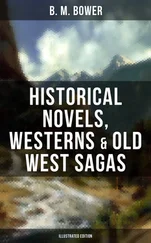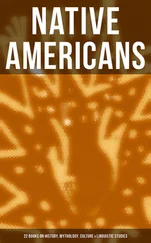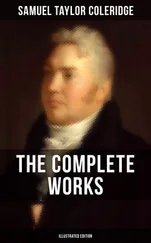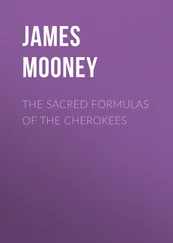By these two defeats the forces of the Cherokee and their confederates were completely broken up. A part of the Cherokee recrossed Red river and rejoined their kinsmen in Indian territory, bringing with them the blood-stained canister containing the patent for their Texas land, which Bowl had carried about with him since the treaty with Houston and which he had upon his person when shot. It is still kept in the Nation.367 Others, with the Kickapoo, Delawares, and Caddo, scattered in small bands along the western Texas frontier, where they were occasionally heard from afterward. On Christmas day of the same year a fight occurred on Cherokee creek, San Saba county, in which several Indians were killed and a number of women and children captured, including the wife and family of the dead chief Bowl.368 Those of the Cherokee who did not return to Indian territory gradually drifted down into Mexico, where some hundreds of them are now permanently and prosperously domiciled far south in the neighborhood of Guadalajara and Lake Chapala, communication being still kept up through occasional visits from their kinsmen in the territory.369
The Cherokee Nation in the West—1840–1900
Table of Contents
With the final removal of the Cherokee from their native country and their reunion and reorganization under new conditions in Indian Territory in 1840 their aboriginal period properly comes to a close and the rest may be dismissed in a few paragraphs as of concern rather to the local historian than to the ethnologist. Having traced for three full centuries their gradual evolution from a savage tribe to a civilized Christian nation, with a national constitution and national press printed in their own national alphabet, we can afford to leave the rest to others, the principal materials being readily accessible in the Cherokee national archives at Tahlequah, in the files of the Cherokee Advocate and other newspapers published in the Nation, and in the annual reports and other documents of the Indian office.
For many years the hunter and warrior had been giving place to the farmer and mechanic, and the forced expatriation made the change complete and final. Torn from their native streams and mountains, their council fires extinguished and their townhouses burned behind them, and transported bodily to a far distant country where everything was new and strange, they were obliged perforce to forego the old life and adjust themselves to changed surroundings. The ballplay was neglected and the green-corn dance proscribed, while the heroic tradition of former days became a fading memory or a tale to amuse a child. Instead of ceremonials and peace councils we hear now of railroad deals and contracts with cattle syndicates, and instead of the old warrior chiefs who had made the Cherokee name a terror—Oconostota, Hanging-maw, Doublehead, and Pathkiller—we find the destinies of the nation guided henceforth by shrewd mixed-blood politicians, bearing white men’s names and speaking the white man’s language, and frequently with hardly enough Indian blood to show itself in the features.
The change was not instantaneous, nor is it even yet complete, for although the tendency is constantly away from the old things, and although frequent intermarriages are rapidly bleaching out the brown of the Indian skin, there are still several thousand full-blood Cherokee—enough to constitute a large tribe if set off by themselves—who speak only their native language and in secret bow down to the nature-gods of their fathers. Here, as in other lands, the conservative element has taken refuge in the mountain districts, while the mixed-bloods and the adopted whites are chiefly on the richer low grounds and in the railroad towns.
On the reorganization of the united Nation the council ground at Tahlequah was designated as the seat of government, and the present town was soon afterward laid out upon the spot, taking its name from the old Cherokee town of Tălikwă′, or Tellico, in Tennessee. The missions were reestablished, the Advocate was revived, and the work of civilization was again taken up, though under great difficulties, as continued removals and persecutions, with the awful suffering and mortality of the last great emigration, had impoverished and more than decimated the Nation and worn out the courage even of the bravest. The bitterness engendered by the New Echota treaty led to a series of murders and assassinations and other acts of outlawry, amounting almost to civil war between the Ross and Ridge factions, until the Government was at last obliged to interfere. The Old Settlers also had their grievances and complaints against the newcomers, so that the history of the Cherokee Nation for the next twenty years is largely a chronicle of factional quarrels, through which civilization and every good work actually retrograded behind the condition of a generation earlier.
Sequoya, who had occupied a prominent position in the affairs of the Old Settlers and assisted much in the reorganization of the Nation, had become seized with a desire to make linguistic investigations among the remote tribes, very probably with a view of devising a universal Indian alphabet. His mind dwelt also on the old tradition of a lost band of Cherokee living somewhere toward the western mountains. In 1841 and 1842, with a few Cherokee companions and with his provisions and papers loaded in an ox cart, he made several journeys into the West, received everywhere with kindness by even the wildest tribes. Disappointed in his philologic results, he started out in 1843 in quest of the lost Cherokee, who were believed to be somewhere in northern Mexico, but, being now an old man and worn out by hardship, he sank under the effort and died—alone and unattended, it is said—near the village of San Fernando, Mexico, in August of that year. Rumors having come of his helpless condition, a party had been sent out from the Nation to bring him back, but arrived too late to find him alive. A pension of three hundred dollars, previously voted to him by the Nation, was continued to his widow—the only literary pension in the United States. Besides a wife he left two sons and a daughter.370 Sequoyah district of the Cherokee Nation was named in his honor, and the great trees of California ( Sequoia gigantea ) also preserve his memory.
In 1846 a treaty was concluded at Washington by which the conflicting claims of the Old Settlers and later emigrants were adjusted, reimbursement was promised for sums unjustly deducted from the five-million-dollar payment guaranteed under the treaty of 1835, and a general amnesty was proclaimed for all past offenses within the Nation.371 Final settlement of the treaty claims has not yet been made, and the matter is still a subject of litigation, including all the treaties and agreements up to the present date.
In 1859 the devoted missionary Samuel Worcester, author of numerous translations and first organizer of the Advocate , died at Park Hill mission, in the Cherokee Nation, after thirty-five years spent in the service of the Cherokee, having suffered chains, imprisonment, and exile for their sake.372
The breaking out of the civil war in 1861 found the Cherokee divided in sentiment. Being slave owners, like the other Indians removed from the southern states, and surrounded by southern influences, the agents in charge being themselves southern sympathizers, a considerable party in each of the tribes was disposed to take active part with the Confederacy. The old Ridge party, headed by Stand Watie and supported by the secret secession organization known as the Knights of the Golden Circle, declared for the Confederacy. The National party, headed by John Ross and supported by the patriotic organization known as the Kitoowah society—whose members were afterward known as Pin Indians—declared for strict neutrality. At last, however, the pressure became too strong to be resisted, and on October 7, 1861, a treaty was concluded at Tahlequah, with General Albert Pike, commissioner for the Confederate states, by which the Cherokee Nation cast its lot with the Confederacy, as the Creeks, Choctaw, Chickasaw, Seminole, Osage, Comanche, and several smaller tribes had already done.373
Читать дальше












